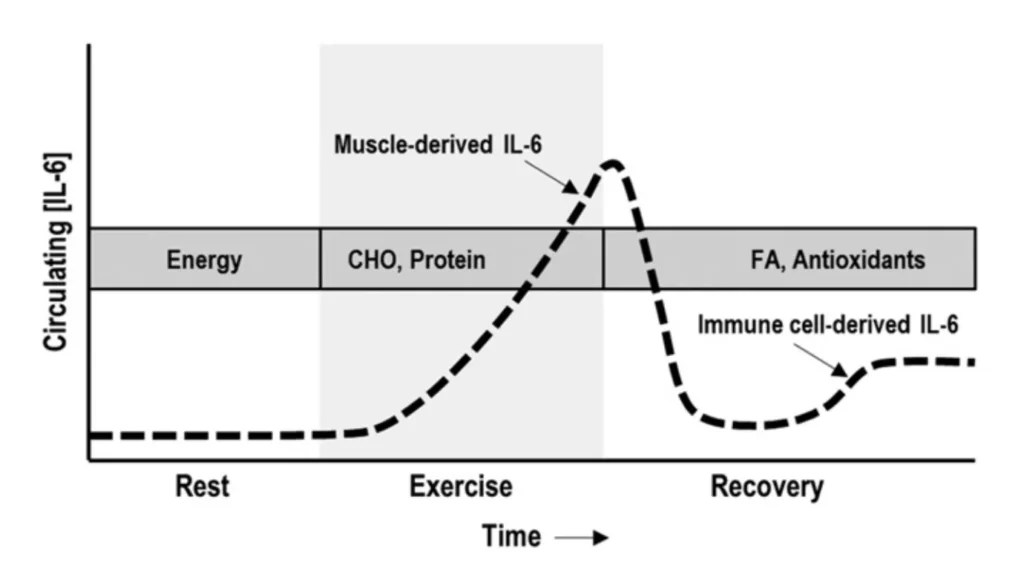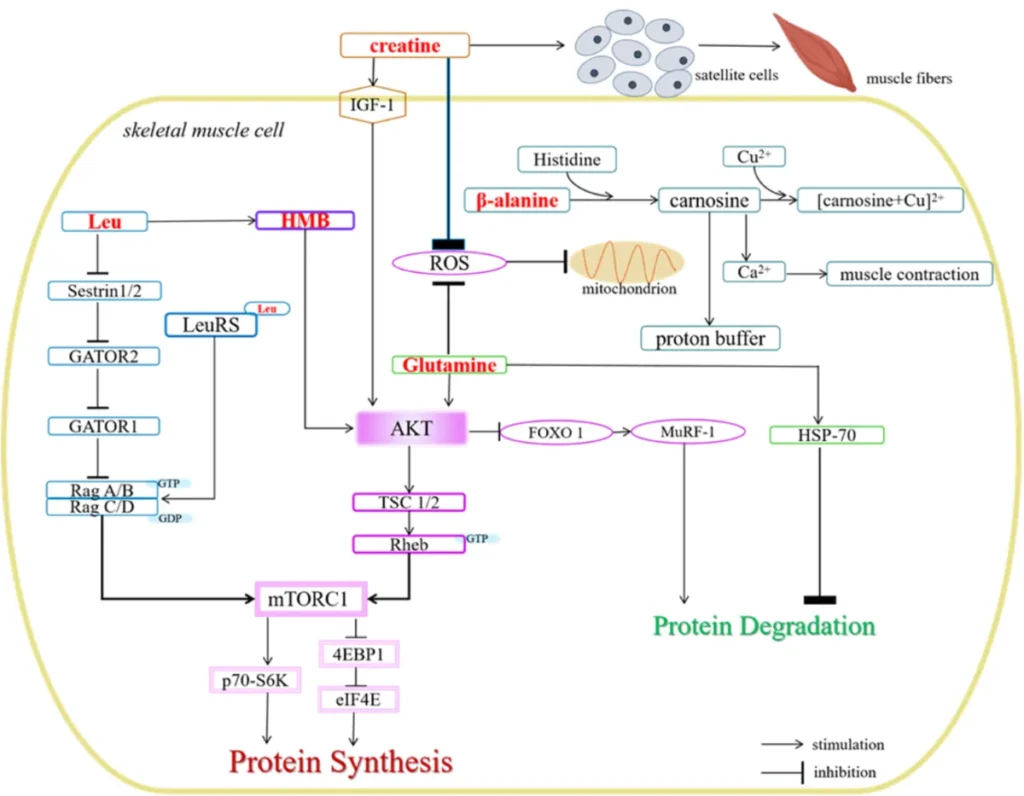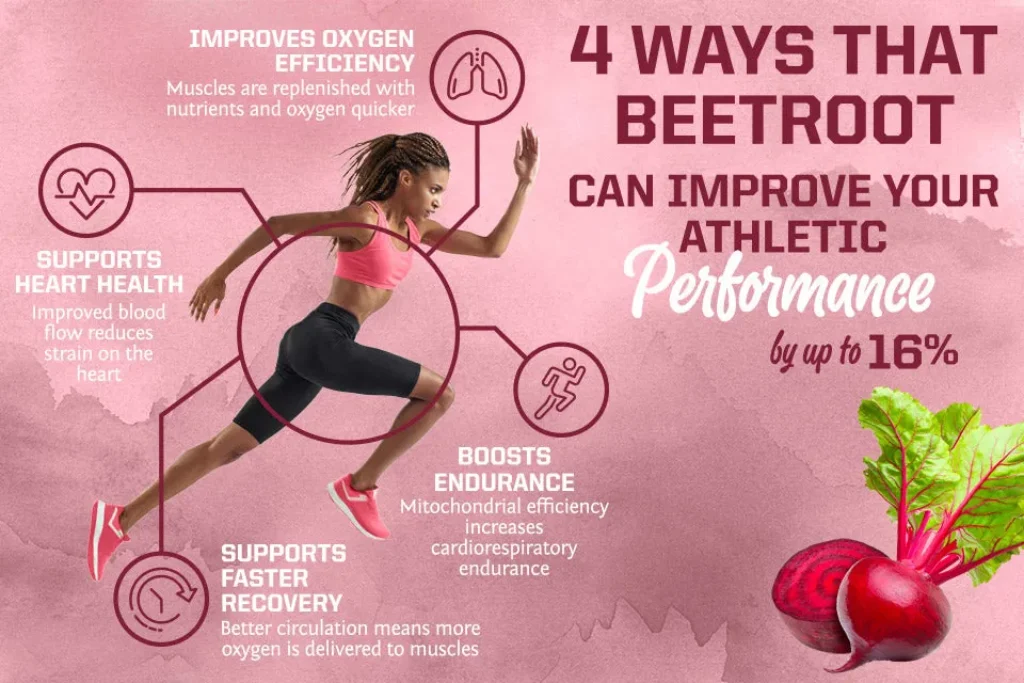Science-Backed Muscle Recovery Supplements: What Research Actually Proves Works

Exercise-induced muscle damage (EIMD) can significantly affect your training. The effects might last up to 14 days based on the severity of the damage. While muscle recovery supplements promise quick fixes, knowing what actually works is vital for optimizing athletic performance and managing oxidative stress. Understanding the best polyphenol supplements and oxidative stress supplements can make a significant difference in your recovery strategy.
Research shows that 40-100% of trained athletes rely on supplements to improve their recovery. However, scientific evidence supports just a few of these supplements. Tart cherry juice, rich in anthocyanins and other polyphenols, and omega-3 fatty acids are the only two nutrients consistently proven to speed up post-exercise recovery. Protein supplements also show promising results. They help athletes maintain maximal strength and reduce muscle damage markers 48-72 hours after exercise.
This comprehensive guide delves into the science behind popular muscle recovery and endurance supplements. You’ll find research-backed dosages and timing recommendations that work. The guide also reveals the best supplement combinations to optimize your post-workout recovery and combat exercise-induced oxidative stress.
Understanding Muscle Recovery After Exercise

To understand why certain muscle recovery supplements work (or don’t), it’s crucial to learn what happens to your muscles during and after intense exercise. Your body goes through a complex chain of events that ultimately determines how well you’ll recover and adapt when you push through challenging workouts.
What happens during exercise-induced muscle damage (EIMD)
We typically observe muscle damage with unaccustomed or eccentric exercise—movements where muscles lengthen under tension, like lowering weights or downhill running. These exercises cause noticeable structural changes at the cellular level. Sarcomere damage, cytoskeletal disruption, and increased permeability of the sarcolemma (muscle cell membrane) occur with extreme eccentric exercise.
The microscopic damage manifests as unaligned sarcomeres, Z-line streaming, disrupted I-bands, and disorganized cytoskeletal elements such as desmin and dystrophin. T-tubule damage and swollen mitochondria appear and compromise the muscle’s functional capabilities. These structural disruptions demonstrate a right shift in the muscle’s active length-tension diagram and a significant active tension.
EIMD disrupts calcium homeostasis. Resting calcium levels increase and trigger calpain-mediated protein breakdown. This calcium influx comes from the extracellular space through stretch-activated channels instead of internal stores. The damage process initiates both immediate tissue breakdown and signals for repair.
The role of inflammation and oxidative stress in recovery
The body activates an inflammatory response immediately after muscle damage occurs. White blood cell counts increase with a notable neutrophil spike within 24 hours. Pro-inflammatory cytokines—especially interleukin-1β (IL-1β) and tumor necrosis factor alpha (TNF-α)—start producing locally and continue for up to 5 days after exercise.
M1 macrophages (also called CD68+ or ED1+) peak around day 2 during this early inflammatory phase. M2 (ED2+) macrophages then replace M1 macrophages under the influence of Th2 cytokines (IL-4, IL-10, and IL-13). This macrophage shift plays a vital role in repair and remodeling through satellite cell activation.
Intense physical activity also triggers increased production of reactive oxygen species (ROS) that shifts the redox balance toward oxidation. These ROS can cause damage, but also function as secondary messengers in gene expression regulation to facilitate exercise adaptation. Research shows that muscle contractions intensify ROS production during peak training loads, which can lead to:
- Higher muscle damage markers in blood (like creatine kinase)
- Problems with the immune system functioning
- Fatigue or overtraining symptoms
Inflammation and oxidative stress create a dynamic system where the body uses anti-inflammatory cytokines to balance pro-inflammatory cascades. This delicate balance is a key target for many antioxidant supplements and endurance supplements designed to support recovery.
Why recovery matters for performance and adaptation
Recovery balances training stress. Your muscles grow stronger during rest periods, not during the actual workouts. Tiny tears form in muscle fibers during intense exercise. These tears heal during rest, making muscles bigger and stronger.
Athletes aim to improve performance through systematic resistance training. This improvement requires the right balance of stress, fatigue, and recovery. Without adequate recovery time between sessions, performance drops. Force production decreases temporarily, and injury risk increases.
Studies show that overtraining syndrome affects about 60% of elite athletes and 30% of non-elite endurance athletes. Athletes with this condition show increased body fat, higher dehydration risk, lowered libido, and mood changes.
Recovery needs depend on several factors:
- Training volume (higher volumes require more recovery)
- Proximity to muscle failure (training to failure necessitates longer recovery)
- Exercise selection (eccentric movements and multi-joint exercises demand more time)
Recovery quality shapes adaptation quality. The body needs regular periods of intense but brief physiological stress followed by longer recovery periods. Athletes might experience underrecovery or overreaching when training becomes too intense without sufficient recovery. This can take days or weeks to restore performance.
Recovery isn’t just time off. It’s an active process that includes rest, nutrition, rehydration, repair, and restoration to bring your body back to normal, ready for the next training session. Evidence-based muscle recovery supplements and endurance supplements can play a crucial role during this process.
Materials and Methods: How Supplement Efficacy is Measured
Scientists need strict methods to measure how well muscle recovery supplements work and detect changes in the body. Understanding how researchers review these supplements is crucial before believing product claims. This knowledge provides key insights into their real benefits and helps athletes make informed decisions about endurance supplements and antioxidant supplements.
Biomarkers used in muscle recovery studies (CK, LDH, IL-6)
Researchers use specific blood biomarkers as biological signs to measure muscle damage and recovery. These markers serve as the gold standard to measure how well supplements work:
Creatine Kinase (CK): This enzyme appears most often in supplement research, with 16 out of 18 studies in one comprehensive analysis using CK as their primary muscle damage marker. Muscle membrane damage causes CK to leak into the blood. The levels peak 24-48 hours after exercise. Higher CK levels indicate more significant muscle membrane damage.
Lactate Dehydrogenase (LDH): LDH, another enzyme released during muscle damage, appears in about 56% of muscle recovery studies. LDH activity shows faster and stronger responses than CK. One study demonstrated most likely large increases (1.30-1.35 standard deviations above baseline) immediately after high-intensity interval training.
Inflammatory Markers: Interleukin-6 (IL-6) stands out as the main inflammatory biomarker, along with TNF-α, C-reactive protein (CRP), and total antioxidant capacity (TAC). These compounds help researchers understand how supplements might modulate the inflammatory response after exercise.
Subjective Measures: Researchers pair biochemical markers with visual analog scales to measure delayed onset muscle soreness (DOMS). They also use perceived recovery status (PRS) scales from 0-10 to gauge subjective recovery.
Common exercise protocols to induce EIMD in trials
Research on muscle recovery supplements requires standardized methods to create measurable muscle damage. The literature shows these protocols fall into several categories:
Resistance Exercise: This protocol appears most often (11 out of 22 studies in one analysis). It includes both eccentric and concentric movements. Most protocols use multiple sets (3-5) with moderate-to-high repetitions (8-12) at about 70% of one-repetition maximum.
Pure Eccentric Contractions: Four studies used only eccentric movements. These movements put more mechanical stress on muscle fibers than other types of contractions. The protocols target muscle damage through controlled lengthening under tension.
Endurance Protocols: Middle-to-long distance running (4 studies) and downhill running (1 study) create both metabolic and mechanical stress. These methods raise inflammatory markers more than localized resistance exercise.
Exercise Specificity: Upper-limb exercises cause more muscle damage than lower-limb exercises at matched relative intensities. Local muscle contraction protocols with eccentric movements like drop jumps, calf raises, and arm curls lead to much higher CK activity.
Study designs: placebo-controlled, crossover, and meta-analyses
The research method choice affects how reliable the supplement findings are:
Randomized Controlled Trials (RCTs): The International Olympic Committee calls these the scientific gold standard. One analysis of BCAA supplementation effects looked at 18 RCTs. Eleven studies used double-blinding and seven used single-blinding protocols.
Crossover vs. Parallel Designs: A review of 18 BCAA supplementation studies showed six used crossover designs where participants received both supplement and placebo in different phases. Twelve studies used parallel designs where separate groups received either a supplement or a placebo. Crossover designs help control individual differences.
Meta-Analyses: These statistical methods combine multiple study data to increase statistical power. PRISMA (Preferred Reporting Items for Systematic Reviews and Meta-Analyses) guidelines provide the framework for these analyses. Meta-analyses require at least 3 independent effect sizes to draw meaningful conclusions.
Measurement Timing: Researchers check supplement effects at several points—immediately after exercise, 3 hours, 24 hours, 48 hours, 72 hours, and sometimes 96 hours later. This timeline matches known patterns of biomarker changes and symptoms after EIMD.
These methods help you critically review research claims about muscle recovery supplements and endurance supplements. Good evidence depends on both positive outcomes and strict scientific methods.
Protein for Muscle Recovery: What the Evidence Shows

Protein is the lifeblood of muscle recovery. Research has delved deep into its effectiveness in different forms, timing protocols, and dosages. Scientists have looked beyond marketing claims to uncover what the evidence actually shows about protein’s role in combating oxidative stress and supporting recovery.
Whey vs. plant-based protein in resistance recovery
Your protein source substantially affects its recovery benefits. Whey protein isolate remains the gold standard for muscle growth because it has a complete amino acid profile and high leucine content. This branched-chain amino acid (BCAA) triggers muscle protein synthesis (MPS), which repairs and builds muscle tissue.
Plant-based proteins have become popular alternatives, especially among endurance athletes seeking sustainable options. These proteins face one main challenge – their amino acid makeup. They typically contain less methionine, lysine, and leucine. This explains why some plant proteins don’t boost MPS as well as animal-based options. Yes, it is worth noting that one study comparing whey and soy protein during a nine-month resistance training program found the whey group gained 3.3kg of lean body mass while the soy group gained only 1.8kg.
Absorption rates vary between protein sources. Animal proteins show 85-95% absorption, but whole plant sources reach only 50-75%. Plant protein isolates can match animal proteins’ absorption rates with proper processing. Research shows larger doses of plant protein (33g of soy or 24g of rice protein) can build muscle like whey when combined with resistance exercise.
Timing and dosage: peri-exercise vs. pre-sleep intake
Daily protein distribution patterns affect recovery results. A key study looked at three ways to consume 80g of protein over 12 hours after resistance exercise: 8×10g every 1.5h, 4×20g every 3h, or 2×40g every 6h. The results revealed that 20g consumed every 3 hours provided the best MPS stimulation during recovery.
Research shows that 20-40g of high-quality protein (or 0.25g/kg body weight) immediately after exercise maximizes post-exercise MPS. Additional protein doesn’t seem to further enhance muscle protein synthesis.
Taking protein before bed works well too. Research proves that 30-40g of protein before sleeping increases overnight MPS rates. This provides your body with amino acids to create new muscle protein during sleep and might improve long-term training results.
Meta-analysis findings on strength and soreness outcomes
Meta-analyses provide the best overview of how protein affects recovery. A systematic review of resistance exercise recovery found that protein intake reduced muscle strength loss and helped muscle function recover faster than carbohydrates or no nutrition.
Long-term strength gains look promising, too. One meta-analysis with 680 people showed protein supplementation during resistance training led to 13.5kg more lower-body strength compared to placebo. Another review of 24 randomized controlled trials found protein supplements increased fat-free mass by 0.69kg and leg press strength by 13.5kg versus placebo after extended resistance training.
Science supports consuming 1.6-2.2g/kg body weight of protein daily to maximize muscle protein synthesis. You might need more protein (2.3-3.1g/kg/day) during caloric restriction to maintain muscle mass. Recent evidence hints that consuming more than 3.0g/kg/day could improve body composition in resistance-trained individuals.
Protein timing isn’t the most crucial factor, despite these benefits. A detailed meta-regression analysis that controlled for other variables found no substantial effect of protein timing on muscle growth or strength when total daily protein remained constant. This suggests that consuming enough total protein while engaging in resistance exercise matters most for muscle development.
Polyphenol-Rich Supplements and Their Recovery Potential

Plant-derived polyphenols offer a unique way to help muscles recover. They go beyond regular protein supplements by utilizing powerful antioxidant and anti-inflammatory mechanisms. These compounds neutralize exercise-induced oxidative stress and help modulate inflammatory responses, making them valuable endurance supplements for athletes. Understanding the best polyphenol supplements can significantly enhance your recovery strategy.
Tart cherry extract and its effect on DOMS and inflammation
Tart cherries have emerged as one of the most studied polyphenol-rich supplements that aid post-exercise recovery. Studies show that taking the right amount can speed up muscle function recovery and reduce soreness after intense workouts, making it one of the best fruits for athletes.
The recommended dose is 30 mL of tart cherry juice. Research has established the best timing strategy that includes taking it before and after exercise. Results are optimal when you consume it for 4-5 days before an event and continue for 2-3 days afterward.
Getting the timing right makes a significant difference. Research shows that muscles recover faster only when athletes take tart cherry juice several days before exercising. Scientists now use the term “precovery” instead of recovery to stress how important it is to start supplementation early.
Team sport athletes who took this dose recovered faster. Their countermovement jump performance, maximal voluntary contractions, and sprint times improved within 24-48 hours after exercise. A detailed review of multiple studies backed these benefits. Athletes who took polyphenols showed better recovery of maximal isometric voluntary contraction immediately after exercise and at 24, 48, 72, and 96 hours later.
Pomegranate and blueberry: antioxidant mechanisms
Pomegranate juice packs exceptional antioxidant properties, making it one of the best fruits for recovery. Studies show its antioxidant capacity (TEAC = 18-20) is three times stronger than red wine and green tea (6-8 TEAC). This strength leads to real benefits in the body. Free radicals, oxidative stress, and lipid peroxidation drop by up to 65%.
The benefits of polyphenol supplements depend on the dose. Taking more than 1000mg of polyphenols daily for at least three days before and after exercise gives the best recovery results. These benefits come from the chemical structure of polyphenols. Their phenolic hydroxyl groups can donate electrons to neutralize free radicals.
Pomegranate and other berry-derived polyphenols work through several mechanisms at the molecular level:
- Direct radical scavenging through electron donation
- Inhibition of cyclooxygenase enzymes (COX1 and COX2)
- Reduction of NF-κB expression signaling
- Prevention of NF-κB nuclear translocation
Blueberry supplements, rich in anthocyanins, also help with recovery. One study found that knee extensor strength returned faster after eccentric exercise. Athletes drank a smoothie with 1,360mg polyphenols on exercise day and 420mg during two recovery days.
Curcumin bioavailability and delivery systems
Curcumin, a potent polyphenol found in turmeric, shows promise as an anti-inflammatory agent. Yet poor bioavailability limits how well it works. The body struggles to absorb it, metabolizes it quickly, and clears it from the system fast. Special delivery systems help solve these problems, making curcumin a more effective option among antioxidant supplements.
Scientists have found several ways to improve curcumin bioavailability:
Black pepper’s active compound, piperine, was one of the first solutions. A study showed that 2g of curcumin with 20mg of piperine led to 20 times better absorption compared to curcumin by itself.
Nanoformulation techniques have also made significant improvements in bioavailability. These include liposomal encapsulation, solid lipid nanoparticles, and polymeric nanoparticles. These systems protect curcumin from breaking down in digestion, make it more soluble, and help cells absorb it better.
Commercial products using these technologies absorb much better than regular curcumin powder. Theracurmin® uses nanoparticle colloidal dispersion technology, while Cureit® recreates the natural turmeric matrix through polar-nonpolar sandwich technology.
Amino Acids and Derivatives: BCAAs, HMB, and Glutamine

Specialized amino acids help target muscle recovery through unique physiological mechanisms that go beyond regular protein supplements. These compounds target specific recovery pathways that work synergistically with your nutrition strategy and other endurance supplements.
BCAA supplementation and central fatigue theory
The central fatigue theory illustrates how branched-chain amino acids (BCAAs) can delay exercise-induced fatigue. This theory focuses on how tryptophan and BCAAs compete to cross the blood-brain barrier. Your muscles use BCAAs for energy during long workouts, which reduces their plasma concentration while unbound tryptophan increases. This change allows more tryptophan to enter your brain, which then boosts serotonin (5-HT) production—a neurotransmitter that induces fatigue.
Taking BCAAs increases their concentration in plasma, which can prevent excessive tryptophan from reaching your brain. Research shows athletes who take BCAAs while cycling feel less exhausted mentally and physically. BCAAs provide both mental and physical benefits in specific situations. Taking carbohydrates with BCAAs works even better because it also helps reduce tryptophan uptake independently.
HMB’s role in muscle protein breakdown and repair
β-hydroxy-β-methylbutyrate (HMB), which comes from leucine metabolism, helps reduce muscle breakdown while boosting protein synthesis. Your body converts about 5% of dietary leucine into HMB.
HMB works through several mechanisms:
- It triggers protein synthesis through the mTOR pathway
- It reduces protein breakdown by blocking the ubiquitin-proteasome system
- It lowers caspase activity and stops myonuclear apoptosis
Studies show HMB supplements reduce exercise-induced muscle damage and improve muscle growth, strength, and aerobic performance. The benefits are most noticeable in beginners or during intense training periods. HMB also helps preserve lean body mass when you’re inactive or on bed rest.
Glutamine’s immune-modulating effects post-exercise
Glutamine is a conditionally essential amino acid that plays a vital role in immune function after intense workouts. Hard training sessions deplete glutamine stores as your body uses it to fuel rapidly dividing immune cells.
Research proves glutamine reduces muscle damage markers while maintaining a good balance between catabolic and anabolic hormones after exercise. Studies show glutamine supplements can reduce short-term strength loss after eccentric exercise and might decrease muscle soreness by modulating inflammation.
Athletes who train intensely often experience glutamine depletion along with weakened immunity. Taking glutamine supplements can help boost immune function after hard workouts. Regular moderate training improves glutamine availability by creating a positive balance between muscle synthesis and peripheral clearance.
Nitrate and Creatine: Performance-Enhancing Recovery Aids

Two muscle recovery supplements stand out from the rest: nitrate and creatine. These compounds offer dual benefits that boost both performance and post-exercise recovery. Each supplement works differently in your body to help you recover between training sessions and combat oxidative stress.
Creatine monohydrate and post-exercise muscle function
Creatine monohydrate works exceptionally well to boost post-exercise recovery. Research shows that supplements improve maximal power, strength, anaerobic capacity, and sprint performance by 5-15%. Single-effort sprints see improvements of 1-5%.
Creatine supplements speed up recovery between intense workouts substantially. Research shows that people taking creatine expressed 21% higher isometric and 10% higher isokinetic knee extension strength while recovering from exercise-induced muscle damage. Their plasma creatine kinase levels were also 84% lower than the placebo group after 48-96 hours.
These recovery benefits occur because creatine:
- Activates satellite cells to repair micro-tears
- Maintains cell hydration to reduce cramping
- Helps produce anabolic hormones
Recent studies suggest taking creatine after workouts might work better than before, especially to improve body composition.
Beetroot juice and nitrate’s role in oxygen delivery
Your body converts the nitrate in beetroot juice (BRJ) into nitric oxide (NO). This creates better blood flow that helps deliver oxygen and nutrients to muscles, making it an excellent supplement for endurance athletes.
BRJ reduces how much oxygen your muscles need during exercise. Studies show that drinking BRJ decreases VO2 during moderate exercise. Your muscles can do the same work using less oxygen, which aids recovery and helps combat oxidative stress.
Nitrates help recovery in several ways:
- They help switch from anaerobic to aerobic energy production faster
- Reduce muscle stress
- Lower phosphocreatine is needed for force output
BRJ works best when oxygen is low. Studies found that nitrate improved exercise tolerance and peak oxygen uptake in low-oxygen conditions but had minimal effects in normal conditions.
Synergistic effects with carbohydrate co-ingestion
Taking these supplements with carbohydrates creates better recovery benefits. Studies show that creatine substantially boosts muscle glycogen storage when taken with carbohydrates. One study found 82% more glycogen restored within 24 hours after exhaustive exercise when people combined creatine with high-carbohydrate intake versus a placebo.
Protein and carbohydrates together after exercise boost glycogen synthesis more than carbohydrates alone. Amino acids help release more insulin, which increases muscle glucose uptake.
The best recovery nutrition plan includes taking 1.2g of carbohydrate per kilogram body mass every hour for 4-6 hours after exercise. This maximizes glycogen synthesis. Adding 0.3g/kg of protein creates complete recovery benefits.
Limitations in Current Supplement Research
Many studies examine muscle recovery supplements, but research limitations make it difficult to reach clear conclusions about how well they work. The current evidence comes from studies with inconsistent methods that affect how reliable and practical the results are, especially when it comes to endurance supplements and antioxidant supplements.
Variability in study protocols and participant training status
Research findings often disagree because of differences in how studies are conducted. Exercise models vary substantially – CK activity spikes with local muscle contraction models that use eccentric exercises but not with whole-body workouts. Trained athletes show less muscle damage than untrained participants when doing the same exercises. These baseline differences create problems when researchers try to interpret studies with different participant groups.
The quality of research shows significant differences, too. Only 11 BCAA supplementation studies used double-blinding, while 7 used single-blinding protocols. These inconsistencies, combined with different eligibility rules about study design, training status, sex, and exercise protocols, have a substantial impact on meta-analysis results.
Lack of female-focused and long-term studies
Women are underrepresented in supplement research. Some analyses show major gender gaps in both clinical trials and research article authorship. To name just one example, the landmark Physicians’ Health Study on aspirin’s effect on cardiovascular disease looked at 22,000 participants – yet not one was female.
Moreover, pregnant individuals are rarely included in trials. This gender gap stands out most during early supplement development when researchers set dosing and safety guidelines. This lack of diversity limits our understanding of how supplements like polyphenols and antioxidants might affect different populations.
Challenges in standardizing soreness and function metrics
Studies use different ways to evaluate muscle damage and recovery. The wide range of muscle damage markers substantially weakens the evidence. Even direct measurements like delayed onset muscle soreness show significant differences between individuals. This makes it hard to spot subtle supplement effects without proper study designs.
The lack of standard methods—including consistent measures, timing, and assessment tools—has stymied our progress in understanding exercise-induced muscle damage mechanisms and recovery strategies. This variability makes it challenging to compare results across studies, especially when evaluating the efficacy of endurance supplements and antioxidant supplements.
Practical Guidelines for Choosing the Best Recovery Supplements
Athletes need a scientific approach to choose supplements wisely. Marketing claims can be misleading, and the wrong choices might waste your money or hurt your training results. Understanding how to evaluate supplement quality and efficacy is crucial for optimizing your recovery strategy.
How to assess supplement quality and bioavailability
Your body’s ability to absorb and use supplements determines their effectiveness. This depends on their chemical makeup, how they’re manufactured, and what you eat. These factors change absorption rates significantly. To name just one example, your body absorbs magnesium citrate better than magnesium oxide.
Quality supplements share these features:
- Third-party testing: Athletes should pick products that independent agencies like NSF.org, Informed Choice, or Banned Substances Control Group have certified. This helps avoid banned substances and ensures product purity.
- Full disclosure: Many products hide behind proprietary blends and don’t show exact amounts. Look for supplements that clearly list all ingredients and their quantities.
- Form matters: Coated tablets work better with 6.58% absorption compared to uncoated tablets at 2.59%. Consider the delivery form when choosing supplements.
Recommended dosages for top evidence-backed supplements
Research shows these dosages work best for various recovery and endurance supplements:
- BCAAs: 10-30g daily proves safe and effective
- Creatine monohydrate: Start with 20g (4×5g) for 5-7 days, then maintain with 3-5g daily
- Beetroot juice: 2 cups daily over several weeks shows benefits without risks
- Beta-alanine: 1.6-6.4g/day for up to 8 weeks is safe
- Turmeric: 1.5-5g daily works better with piperine from black pepper
- Tart cherry juice: 30 mL twice daily, starting 4-5 days before intense exercise
- Pomegranate juice: 500 mL daily for improved recovery and antioxidant effects
When to avoid certain supplements to preserve adaptation
Research now shows that some supplements, especially high-dose antioxidants, might block training benefits. Exercise creates reactive oxygen species that actually help muscle adaptation. This insight has led to a more nuanced approach to using antioxidant supplements.
Taking vitamins C and E can reduce important training gains. These supplements decrease key genes that help build mitochondria, including PGC-1α. Studies consistently show that antioxidants can hinder adaptations to intense training.
Athletes love antioxidant supplements, but science doesn’t support their use for better training results. The smart approach uses these supplements during competitions when recovery matters most. You should avoid them during heavy training phases that focus on adaptation.
Instead, focus on whole foods rich in polyphenols and other natural antioxidants. Fruits like blueberries, pomegranates, and tart cherries offer antioxidant benefits without compromising training adaptations. These foods provide a balanced mix of nutrients that support both recovery and long-term performance gains.
Conclusion
Research shows that the right supplements can significantly improve muscle recovery. Scientists have found specific daily doses work best: protein (1.6-2.2g/kg), tart cherry extract (30 mL twice), and creatine monohydrate (3-5g maintenance). These evidence-based recommendations provide a solid foundation for athletes looking to optimize their recovery strategies.
Supplement companies often exaggerate their products’ benefits. Still, some compounds actually help recovery through specific body mechanisms. Extra protein helps maintain strength and speeds up muscle recovery. Athletes who consistently take tart cherry extract before and after workouts experience less inflammation and soreness. Creatine makes muscles work better after exercise and reduces damage markers by up to 84%.
The research comes with some limitations you should consider. Many studies lack standard methods, mostly test male subjects, and don’t explore long-term effects. To make informed choices, carefully check product quality, bioavailability, and third-party testing certifications.
A successful supplement plan matches proven research with your workout needs. Stick to tested compounds at recommended doses. Skip high-dose antioxidants during intense training periods. This targeted strategy helps you get the most recovery benefits while preserving essential training adaptations.
Remember that supplements are just one part of a comprehensive recovery strategy. Proper nutrition, adequate sleep, and smart training periodization are equally important. By combining evidence-based supplements with these foundational practices, athletes can optimize their recovery, reduce the risk of overtraining, and ultimately enhance their performance.
FAQs
Q1. What are the most effective supplements for muscle recovery according to research?
Studies show that protein (1.6-2.2g/kg daily), tart cherry extract (30 mL twice daily), and creatine monohydrate (3-5g maintenance dose) are among the most effective supplements for enhancing muscle recovery when used properly. These supplements have consistently demonstrated benefits in reducing muscle damage, inflammation, and improving recovery time.
Q2. How does tart cherry extract aid in muscle recovery?
Tart cherry extract, rich in anthocyanins and other polyphenols, helps reduce inflammation and muscle soreness when consumed both before and after exercise. It’s most effective when taken for 4-5 days before an event and 2-3 days after, a strategy researchers call “precovery.” This approach helps prepare the body for intense exercise and supports faster recovery afterward.
Q3. Are plant-based proteins as effective as whey protein for muscle recovery?
While whey protein is generally considered superior due to its complete amino acid profile, plant-based proteins can be effective when consumed in larger quantities. For example, 33g of soy protein or 24g of rice protein can produce comparable muscle growth results to whey when combined with resistance exercise. The key is ensuring adequate intake of all essential amino acids.
Q4. How does creatine supplementation impact post-exercise recovery?
Creatine supplementation has been shown to improve post-exercise muscle function and significantly reduce muscle damage markers. Studies indicate it can lead to 21% higher isometric and 10% higher isokinetic knee extension strength during recovery from exercise-induced muscle damage. Creatine also helps maintain cell hydration and supports the activation of satellite cells for muscle repair.
Q5. Should athletes avoid antioxidant supplements during training?
Some evidence suggests that high-dose antioxidant supplements, particularly vitamins C and E, may interfere with training adaptations. These supplements can reduce the expression of key genes involved in mitochondrial biogenesis, potentially hindering long-term performance gains. Athletes should focus on obtaining antioxidants from whole foods rich in polyphenols, such as berries and pomegranates, which offer balanced nutritional benefits without compromising training adaptations.
References
[1] – https://pmc.ncbi.nlm.nih.gov/articles/PMC6445811/
[2] – https://pubmed.ncbi.nlm.nih.gov/16424144/
[3] – https://www.verywellhealth.com/nutrition-and-supplements-for-muscle-recovery-8374467
[4] – https://www.mdpi.com/2072-6643/14/1/70
[5] – https://pmc.ncbi.nlm.nih.gov/articles/PMC8228369/
[6] – https://pmc.ncbi.nlm.nih.gov/articles/PMC8540263/
[7] – https://pmc.ncbi.nlm.nih.gov/articles/PMC2245953/
[8] – https://pubmed.ncbi.nlm.nih.gov/19841583/
[9] – https://www.sciencedirect.com/science/article/abs/pii/S1089860319303325
[10] – https://link.springer.com/article/10.1007/s40279-025-02213-6
[11] – https://pmc.ncbi.nlm.nih.gov/articles/PMC11013223/
[12] – https://sportsmedicine-open.springeropen.com/articles/10.1186/s40798-024-00686-9
[13] – https://www.sciencedirect.com/science/article/pii/S1728869X22000351
[14] – https://pmc.ncbi.nlm.nih.gov/articles/PMC9573146/
[15] – https://pubmed.ncbi.nlm.nih.gov/28696985/
[16] – https://pmc.ncbi.nlm.nih.gov/articles/PMC9306613/
[17] – https://www.mdpi.com/2072-6643/13/9/2988
[18] – https://pmc.ncbi.nlm.nih.gov/articles/PMC5072630/
[19] – http://www.gssiweb.org/sports-science-exchange/article/fruit-derived-polyphenol-supplementation-for-performance-and-recovery
[20] – https://www.mdpi.com/1999-4923/16/5/637
[21] – https://www.sciencedirect.com/science/article/pii/S002231662208097X
[22] – https://www.sciencedirect.com/science/article/pii/S0022316622080488
[23] – https://www.gssiweb.org/sports-science-exchange/article/sse-61-carbohydrates-branched-chain-amino-acids-and-endurance-the-central-fatigue-hypothesis
[24] – https://pmc.ncbi.nlm.nih.gov/articles/PMC5566641/
[25] – https://examine.com/supplements/hmb/
[26] – https://pmc.ncbi.nlm.nih.gov/articles/PMC8234492/
[27] – https://jissn.biomedcentral.com/articles/10.1186/1550-2783-6-13
[28] – https://pmc.ncbi.nlm.nih.gov/articles/PMC8401986/
[29] – https://www.tandfonline.com/doi/full/10.1080/10408398.2020.1746629
[30] – https://pmc.ncbi.nlm.nih.gov/articles/PMC7803445/
[31] – https://www.forbes.com/councils/forbesbusinessdevelopmentcouncil/2023/03/07/ignored-and-underrepresented-the-impact-of-excluding-women-in-healthcare-research/
[32] – https://www.aamc.org/news/why-we-know-so-little-about-women-s-health
[33] – https://www.researchgate.net/publication/259770270_Effects_of_Protein_Supplements_on_Muscle_Damage_Soreness_and_Recovery_of_Muscle_Function_and_Physical_Performance_A_Systematic_Review
[34] – https://www.nature.com/articles/s41430-022-01250-y
[35] – https://www.mdpi.com/2072-6643/17/5/748
[36] – https://ods.od.nih.gov/factsheets/ExerciseAndAthleticPerformance-HealthProfessional/
[37] – https://longevity.stanford.edu/lifestyle/2024/03/11/supplements-for-athletic-recovery/
[38] – https://pmc.ncbi.nlm.nih.gov/articles/PMC4001759/
[39] – https://pmc.ncbi.nlm.nih.gov/articles/PMC5023714/
[40] – https://pmc.ncbi.nlm.nih.gov/articles/PMC8549894/
[41] – https://www.nature.com/articles/s41598-024-65309-5
[42] – https://www.uchealth.org/today/rest-and-recovery-for-athletes-physiological-psychological-well-being/
[43] – https://pmc.ncbi.nlm.nih.gov/articles/PMC11057610/
[44] – https://www.sciencedirect.com/science/article/abs/pii/S2468867319300379
[45] – https://link.springer.com/article/10.1007/s40279-022-01640-z
[46] – https://pmc.ncbi.nlm.nih.gov/articles/PMC5384061/
[47] – https://examine.com/research-feed/study/dBl7e0/?srsltid=AfmBOooxBNEoMZhxZnR8ipxZfkpqG8t4iSewoQDhhxDrWcfkykIGiFRo
[48] – https://www.tandfonline.com/doi/full/10.1080/15502783.2023.2204083
[49] – https://pmc.ncbi.nlm.nih.gov/articles/PMC9736198/
[50] – https://pmc.ncbi.nlm.nih.gov/articles/PMC8746365/
[51] – https://www.healthline.com/nutrition/whey-vs-plant-protein
[52] – https://us.myprotein.com/thezone/supplements/whey-vs-plant-protein-for-muscle-protein-synthesis-nutritionist-reviews/
[53] – https://pmc.ncbi.nlm.nih.gov/articles/PMC3650697/
[54] – https://pmc.ncbi.nlm.nih.gov/articles/PMC5477153/
[55] – https://www.mdpi.com/2072-6643/8/12/763
[56] – https://pmc.ncbi.nlm.nih.gov/articles/PMC3879660/
[57] – https://www.sciencedirect.com/science/article/pii/S0002916523029271
[58] – https://www.usada.org/spirit-of-sport/when-consume-protein-muscle-growth/






